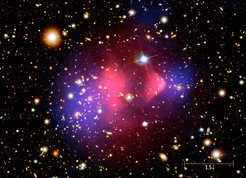No evidence for sterile neutrinos in galaxy clusters

This image shows the ‘bullet cluster’ in X-rays, one of the galaxy clusters analysed in the recent sample.
Several groups have found indications for a weak unidentified emission line in X-ray spectra of the Andromeda galaxy and deep observations of galaxy clusters. This line, with an energy of 3.55keV, could be explained by the decay of so-called sterile neutrinos, a hypothetical particle proposed as a dark matter candidate. However, all evidence so far was from observations with the XMM-Newton satellite, so a group of astronomers at the Max Planck Institute for Extraterrestrial Physics (MPE) decided to analyse archive data on galaxy clusters from the Chandra X-ray observatory.
“We wanted to find out if only a certain type of galaxy cluster shows this line or if it might have been due to some effects related to the instrument,” explains Florian Hofmann, the lead author of the study. “It was the first time that this analysis has been carried out with deep Chandra observations of galaxy clusters.”
The sample included 33 clusters of galaxies that were the most luminous clusters with deep observation data available in the archive. X-ray spectra were analysed both individually and for all the clusters combined – and separately for the two instruments available on-board Chandra. For each spectrum, a model was fitted to the data to be able to subtract contributions from known emission lines and find any additional emission.

This plot shows the merged X-ray spectra of all 33 galaxy clusters in this analysis. One can see slight bumps at about 3.4keV and 3.9keV, which correspond to known emission lines, but no excess emission at 3.55keV.
“None of the individual clusters showed a significant detection of the proposed line at 3.55keV and we do not find evidence for such a line in the merged cluster spectra,” states Florian Hofmann. “This does not rule out that sterile neutrinos exist, but places tight constraints on their possible contribution to dark matter.”
A recent study using the HITOMI satellite confirmed these findings and further observations will be needed to ascertain if this line does indeed exist in large galaxies and galaxy clusters and to find out more about its origin. Alternative explanations could be a plasma emission line of the intra cluster gas or charge exchange between plasma components at different temperatures.













